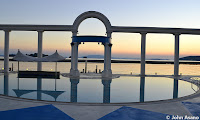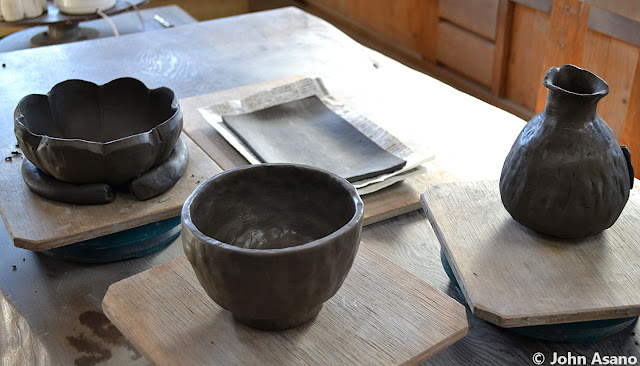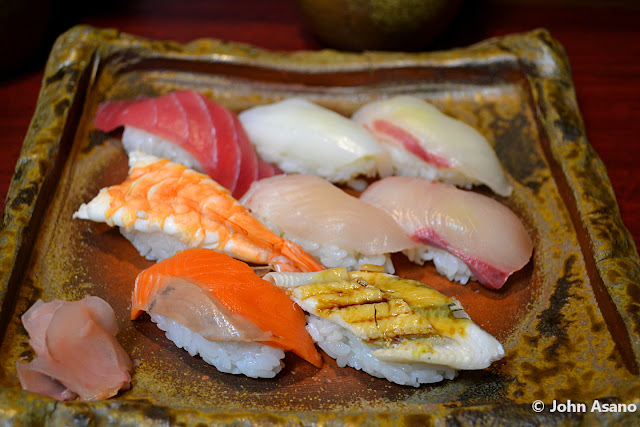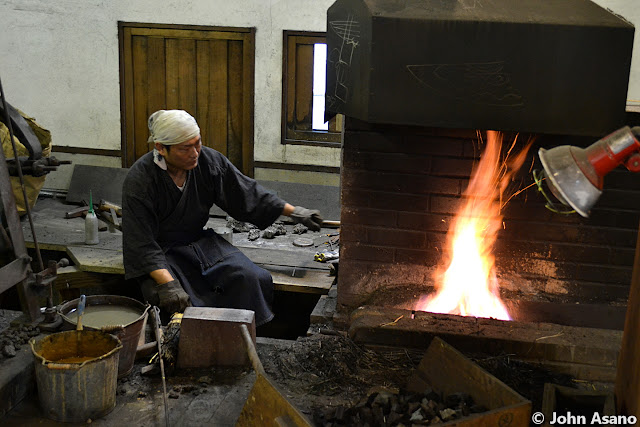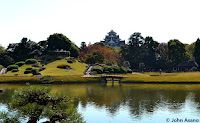The northern part of Okayama Prefecture is famous for its amazing castles, old villages, hot springs and stunning mountain scenery.
Takahashi
Takahashi is an old castle town in Okayama Prefecture full of history, culture and nature, located about 60 minutes from Okayama City.
The most famous attraction in Takahashi is Bitchu Matsuyama Castle, one of only twelve original castles still remaining in Japan. Located atop a 430-meter mountain, it is the highest stronghold in Japan with an existing castle tower. On a cold and clear morning in autumn, a sea of clouds form around the castle, giving the illusion that the castle is floating in the sky. This has earned the castle the cool nickname, “The Castle in the Sky”. The best time to visit Bitchu Matsuyama Castle is very early morning in autumn for the amazing fall foliage and sea of clouds.
 |
| Bitchu Matsuyama Castle floating in a sea of clouds in autumn |
Located deep in the mountains of Takahashi, 550-meters above sea-level is Fukiya Furusato Village, a remote mountain village that is home to a beautiful street of houses with red roof tiles and walls. Here you can visit a one-of-a-kind street in Japan that is painted in traditional “Bengara” a vivid red colour pigment made from oxidized iron. The mountain village once flourished as a copper mining town and major producer of “Bengara” during the late Edo Period (1603-1868) through to the Meiji Period (1868-1912). Today, the uniform red colour of the buildings here hark back to the past as well as appealing to the eye with their aesthetically looking appearance. The red pigment helps preserve the buildings as well as repelling insects, which is definitely a good thing in my book.
The uniform red of the buildings of Fukiya Furusato has earned the village recognition as an Important Preservation District for Groups of Traditional Buildings as well as being labeled as an Important Cultural Asset by the Japanese government. In order to save and preserve these beautiful and historic buildings, the local residents have turned many of them into charming shops selling local handicrafts and museums to inform about the culture and history of the village. Some of the buildings have even been turned into accommodation, where you can rent a house for a stay to soak up the authentic atmosphere further in this magical village.
 |
| Fukiya Furusato Village is painted in traditional Bengara red |
Hiruzen Kogen Highlands
Hiruzen Kogen Highlands in the north of Okayama Prefecture reminds me a lot of the beautiful mountains here in Gifu. Located on a gently sloping plateau, this prominent resort area in Western Japan is famous for its rolling hills and Jersey cows. The best time to visit is spring for the fresh greenery, or autumn for the colourful fall foliage.
Hiruzen Winery is the perfect place to recharge the batteries with delicious western style food made with its famous wine grown from wild mountain grapes. The winery located on a hill overlooking some stunning mountain scenery has some exquisite wine to choose from which has won multiple awards at Japanese wine competitions.
 |
| Amazing views from Hiruzen Winery in the Hiruzen Kogen Highlands of Okayama |
Hiruzen Jersey Land is where you can try some fresh local dairy products made from the milk of the local Jersey cows. The best way to sample some of this Jersey magic is via trying a Jersey milk soft-serve ice cream, or some cheese made from the milk of the area’s most famous residents, the Jersey cows.
The best way to explore the local area is by bike and the Hiruzen Cycling Club gives you the chance to see the beautiful nature of the area in a fun and healthy way. Follow the Hiruzen Kogen Cycle Road to enjoy the beauty nature of each season from the fresh green of spring to the blazing red leaves of autumn.
One of the best nature spots in the area is Shiogama Cold Spring, a natural cold spring located in a secluded valley at the foot of the Naka-Hiruzen Mountains 520 meters above sea level. The cold spring measures 12 meters from north to south, 5 meters from east to west, and is 1.9 meters at its deepest point. It is classified as one of Japan’s Top 100 Springs, and produces 300 liters of water every second.
 |
| Shiogama Cold Spring at the foot of the Naka-Hiruzen Mountains |
Okutsu Onsen
The Okutsu Valley is a picturesque valley that is home to the largest formation of natural potholes in East Asia. The valley is alive with colour during fall with colourful autumn leaves. You can even enjoy a light-up event that offers you the chance to experience the colourful autumn leaves illuminated at night.
 |
| Autumn leaves illuminated at night in the Okutsu Valley |
Okutsu Onsen is a picturesque hot spring town nestled among mountains and mountain streams of Okayama. The water from Okutsu Onsen is said to purify the skin and make you more beautiful. The hot spring water is called “Bijin no Yu” in Japanese, meaning beautifying water.
 |
| Ashiyu foot baths at Okutsu Onsen |
The best place to experience these beautifying waters is at Meisen Kagiyu Okutsuso, a traditional Japanese inn (ryokan) located at Okutsu Onsen. Here you can experience sleeping in a Japanese tatami room with futon and soaking in the natural hot spring baths at the inn. Just outside the inn is a river which has two different ashiyu (foot baths) on either side.
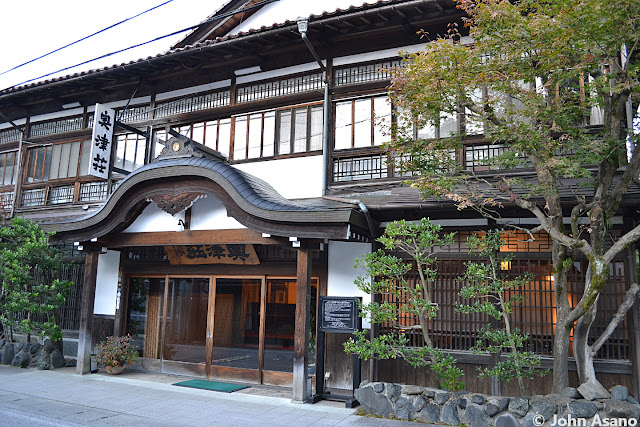 |
| Meisen Kagiyu Okutsuso traditional Japanese inn at Okutsu Onsen |
There you have it, my extensive guide to Okayama Prefecture from the south to the north. After reading this series I think you’d agree that Okayama is full of amazing hidden gems, which make it in my opinion, one of the must-see destinations in Japan.
 |
| Fukiya Furusato Village in Takahashi |


